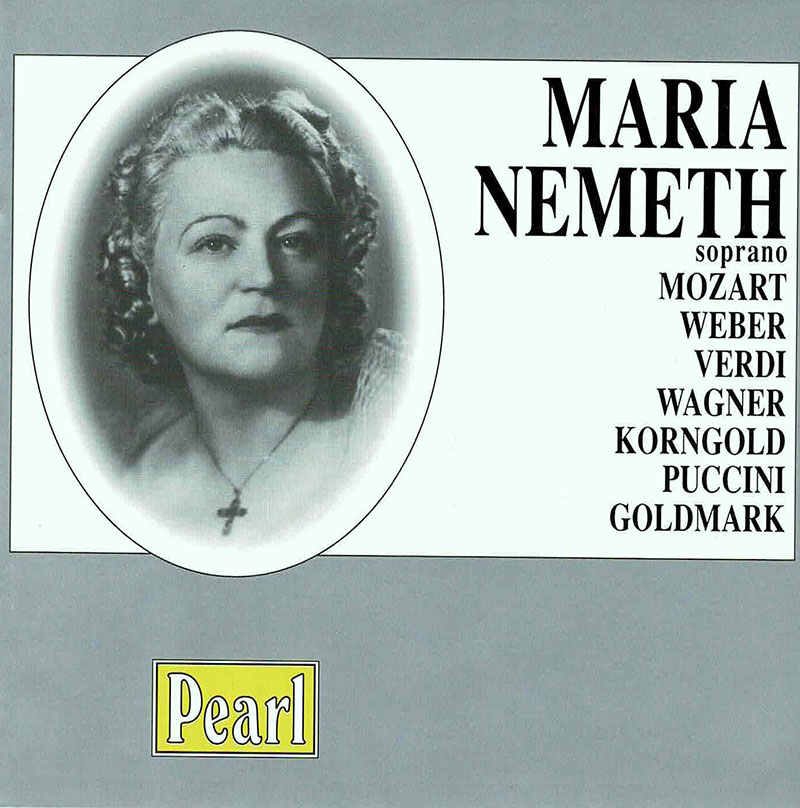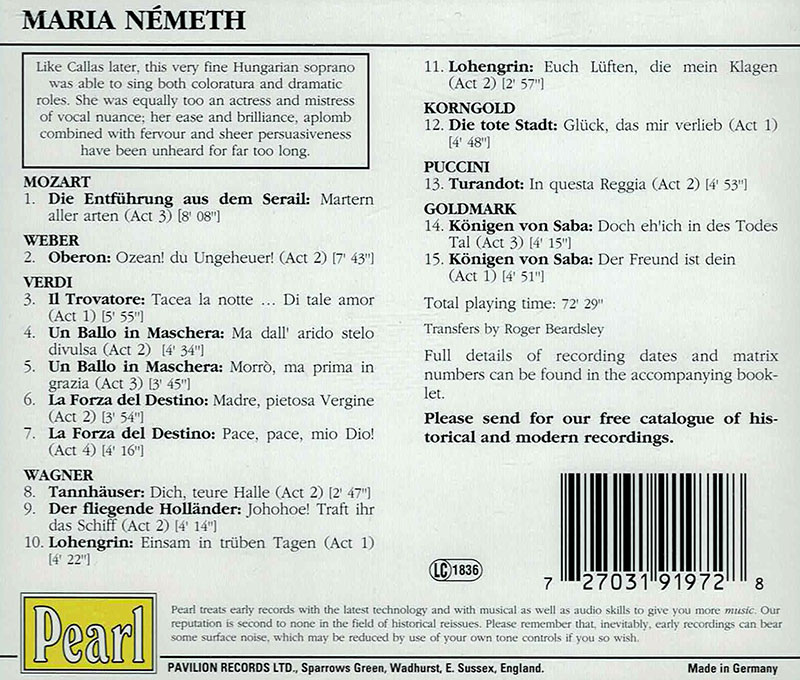Logowanie
KOLEKCJE!
BACH, CHOPIN, LISZT, MOZART, GRIEG, Dinu Lipatti, Otto Ackermann, Ernest Ansermet
The Master Pianist
PROKOFIEV, CHOPIN, TCHAIKOVSKY, SCHUMANN, BEETHOVEN, Martha Argerich, Claudio Abbado, Giuseppe Sinopoli
The Concerto Recordings
The Collection 2
Jakość LABORATORYJNA!
ORFF, Gundula Janowitz, Gerhard Stolze, Dietrich-Fischer Dieskau, Deutsche Oper Berlin, Eugen Jochum
Carmina Burana
ESOTERIC - NUMER JEDEN W ŚWIECIE AUDIOFILII I MELOMANÓW - SACD HYBR
Winylowy niezbędnik
ClearAudio
Essence MC
kumulacja zoptymalizowana: najlepsze z najważniejszych i najważniejsze z najlepszych cech przetworników Clearaudio
Direct-To-Disc
PIAZZOLLA, ChamberJam Europe
Tangos del Ángel y del Diablo
Direct-to-Disc ( D2D ) - Numbered Limited Edition
MOZART, WAGNER, VERDI, PUCCINI, Maria Nemeth
Maria Nemeth

- 1. Die Entführung aus dem Serail, opera, K. 384 Act 3: Martern aller arten
- Composed by Wolfgang Amadeus Mozart
- Performed by Vienna State Opera Orchestra with Maria Nemeth
- 2. Oberon, opera in 3 acts, J306 Act 2: Ozean! du Unngeheuer!
- Composed by Carl Maria von Weber
- Performed by Vienna State Opera Orchestra with Maria Nemeth
- 3. Il Trovatore, opera Act 1: Tacea la notte...Di tale amor
- Composed by Giuseppe Verdi
- with Maria Nemeth
- 4. Un ballo in maschera, opera Act 2: Ma dall' arido stelo divulsa
- Composed by Giuseppe Verdi
- with Maria Nemeth
- 5. Un ballo in maschera, opera Act 3: Morrň, ma prima in grazia
- Composed by Giuseppe Verdi
- with Maria Nemeth
- 6. La forza del destino, opera Act 2: Madre, pietosa Vergine
- Composed by Giuseppe Verdi
- Performed by Vienna State Opera Orchestra with Maria Nemeth
- 7. La forza del destino, opera Act 4: Pace, pace, mio Dio!
- Composed by Giuseppe Verdi
- Performed by Vienna State Opera Orchestra with Maria Nemeth
- 8. Tannhäuser, opera, WWV 70 Act 2: Dich, teure Halle
- Composed by Richard Wagner
- with Maria Nemeth
- 9. Der fliegende Holländer (The Flying Dutchman), opera, WWV 63 Act 2: Johohoe! Traft ihr das Schiff
- Composed by Richard Wagner
- with Maria Nemeth
- 10. Lohengrin, opera, WWV 75 Act 1: Einsam in trüben Tagen
- Composed by Richard Wagner
- with Maria Nemeth
- 11. Lohengrin, opera, WWV 75 Act 2: Euch Lüften, die mein Klagen
- Composed by Richard Wagner
- with Maria Nemeth
- 12. Die tote Stadt (The Dead City), opera, Op. 12 Act 1: Glück, das mir verlieb
- Composed by Erich Wolfgang Korngold
- with Maria Nemeth
- 13. Turandot, opera Act 2: In questa Reggia
- Composed by Giacomo Puccini
- with Maria Nemeth
- 14. Die Königin von Saba, opera, Op. 27 Act 3: Doch eh'ich in des Todes Tal
- Composed by Karl Goldmark
- with Maria Nemeth
- 15. Die Königin von Saba, opera, Op. 27 Act 1: Der Freund ist dein
- Composed by Karl Goldmark
- Performed by Vienna State Opera Orchestra with Maria Nemeth
- Maria Nemeth - soprano
- MOZART
- VERDI
- WAGNER
- PUCCINI
MARIA NEMETH (1897-1967) The career of the Hungarian soprano Maria Nemeth spanned just two decades, was entirely European based and largely Viennese where her reputation in her prime was very considerable. In some ways she was a singer out of her time, more in the mould of a later and better known artist, Maria Callas, in that she was able to sing both lyric coloratura and heavier dramatic roles, an unusual attribute. Maria Nemeth was born in Kórmund, Hungary on 13 March 1897. She studied first in Budapest with Georg Anthes and Geza Laszló. By 1920 she was to be found in Milan studying with the distinguished Italian soprano Giannina Russ. It is even though she might have made her debut as Marguerite in Faust as early as 1920. She did definitely make her Budapest debut as Sulamith in Goldmark's Die Kónigen von Saba in 1923. The following October she went to Naples to study with Fernando de Lucia. Unfortunately the famous tenor died in February 1925, but Nemeth always felt that the experience of these lessons proved highly beneficial in her subsequent career, especially when singing Italian roles. Engaged by the Vienna State Opera for the 1925/6 season, Nemeth sang regularly at the house until 1946. On 15 October 1926 she sang the title role of Turandot at the second Viennese performance (Lotto Lehmann gave the first) when Calaf was sung by the Polish tenor Jan Kiepura. One critic, somewhat acidly, commented "it was especially hard on Calaf to have to answer Turandot's riddles when her Hungarian German was as difficult to understand as his Polish mixture". Maria Nemeth had made her Salzburg Festival debut in August 1926 when she sang Donna Anna opposite Tauber as Ottavio and with Hans Duhan in the title role of Don Giovanni. The two performances were conducted by Franz Schalk who would direct the revivals between 1927 and 1929 when Nemeth repeated the role in which she was greatly admired, where her dramatic soprano of great flexibility and range was ideal. In her single Covent Garden season in 1931 Nemeth sang in just two performances of Turandot. It was noted that she brought her own costumes and one report remarked upon `her bejewelled train completely covered the flight of stairs in the Riddle Scene'. Her singing was warmly appreciated, particularly in the way she `hurled out her questions with the hard defiance which belongs to the character'. The distinguished vocal authority Herman Klein remarked that `Nemeth proved to be the ideal soprano for the hard, cruel, but brilliant part of Turandot ... She also infused extraordinary significance into her acting, and depicting with an absorbing mastery of vocal nuance, the gradual change from furious rage and aversion to passionate love for Prince Calaf'. Her Calaf was the Spanish tenor Antonio Cortis and the conductor Barbi- rolli. Regrettably she was not re-engaged. Until 1932, the year she was made an Austrian Kammersanger, Maria Nemeth sang almost exclusively Italian roles, concentrating on Aida, Il trovatore, La forza del destińo, Un ballo in maschera and Tosca. In Mozart she even essayed the role of the Queen of the night from Die Zauberfote! However, in 1933 the German conductor Clemens Krauss, then in charge of the Vienna State Opera, asked her to sing the Siegfried Brunnhilde. It was around this time Nemeth began to relinquish the coloratura repertoire. In his years in Vienna Krauss kept delaying the premiere of Jenb von Hubay's Anna Karenina. However, following his departure for Berlin, it was eventually given with Nemeth in the title role and Felix Weingartner as conductor. The opera proved a sad failure and soon disappeared from sight. The economic depression confronting the Western world during the 1930s forced the management at the Vienna State Opera to introduce drastic reductions in fees paid to artists and curtail the overall number of performances per season. Maria Nemeth, who was one of the six highest paid artists, had her appearances almost halved. She did, however, continue to sing in Vienna after the German occupation in March 1938, singing, among other roles, that of Marta in a production of D'Albert's Tiefand to mark what would have been the composer's 80th birthday on 4 April 1944. After the cessation of hostilities in Europe in May 1945, following the damage to the Vienna State Opera House, Maria Nemeth sang with the company in the Theater an der Wien for a couple of seasons before retiring, her final appearance being as Santuzza in Cavalleria Rusticana in 1946. Later she taught in Vienna. When the rebuilt Staatsoper was re-opened on 5 November 1955 Maria Nemeth was one of the former stars who were invited as special guests. She died in Vienna on 28 November 1967, aged 70. Maria Nemeth's small number of recordings belie her significance at the time the discs were made and it seems absurd that she was only 32 years old when she made her last visit to the studios. All her discs were made in Vienna, the first batch for Polydor in 1927 and a further later group for the Austrian branch of The Gramophone Company. The published discs probably failed to sell in sufficient quantities, with only two being released in Britain, and by the late 1930s the recordings had disappeared and since have become comparatively rare. The big aria from Turandot displays the appropriate steely cold glitter in her voice and she is able to achieve exactly the right sweep in surmounting the great climax of the aria. Then in contrast is the ease and brilliance of execution, the aplomb and sense of masterfulness in Konstanze's big aria from Die Entfuhrung. This is indeed a strong and independent woman. There is also a dramatic fervour, an outburst of jubilation and a command- ing security in the Oberon aria with a superb top C, contrasting effectively with the lyrical and reflective character of Elsa in Lohengrin. The five examples of her Verdi singing show most positively why Nemeth was so much admired in this composer's music. The fluency of the coloratura in the cabaletta of Leonora's Act 1 aria from Il trovatore is impressive and the two arias from La forza del destino display a strong personality and individuality of interpretation. However, the pick of all the artist's recording must be two arias for Sulamith in Goldmark's Die Kónigen von Saba. Here the ease with which she soars above the assisting chorus is very compelling. Then the music is attractive with a perfumed, almost oriental aroma pervading the whole part. MALCOLM WALKER

























